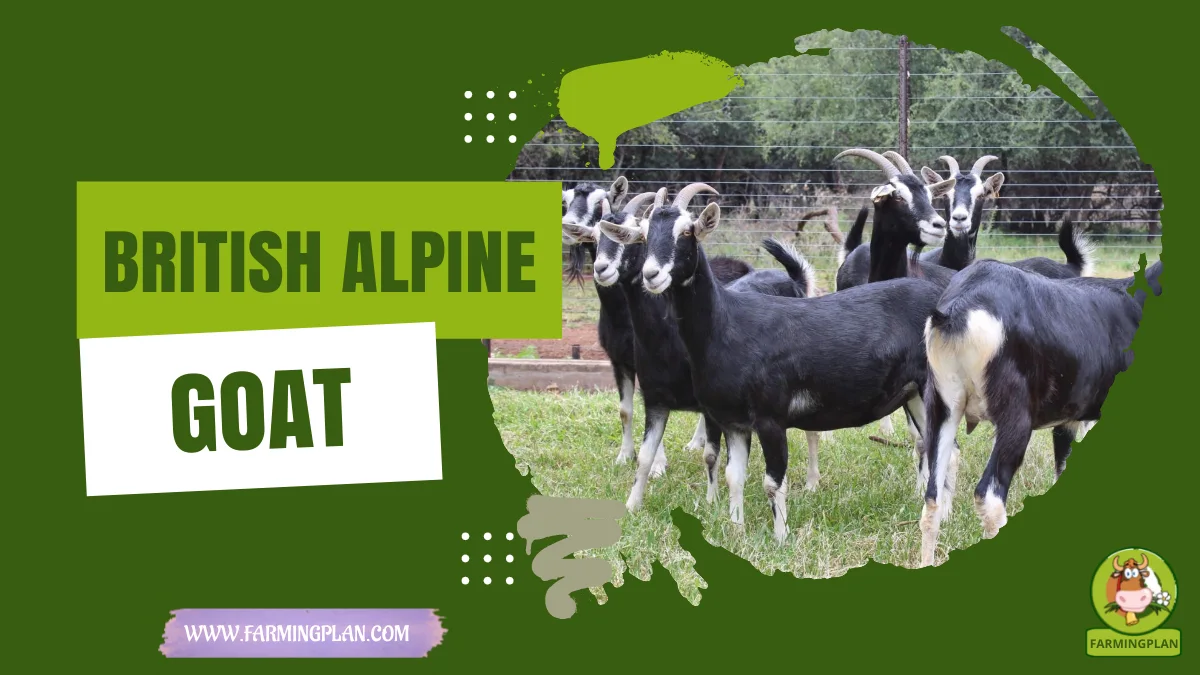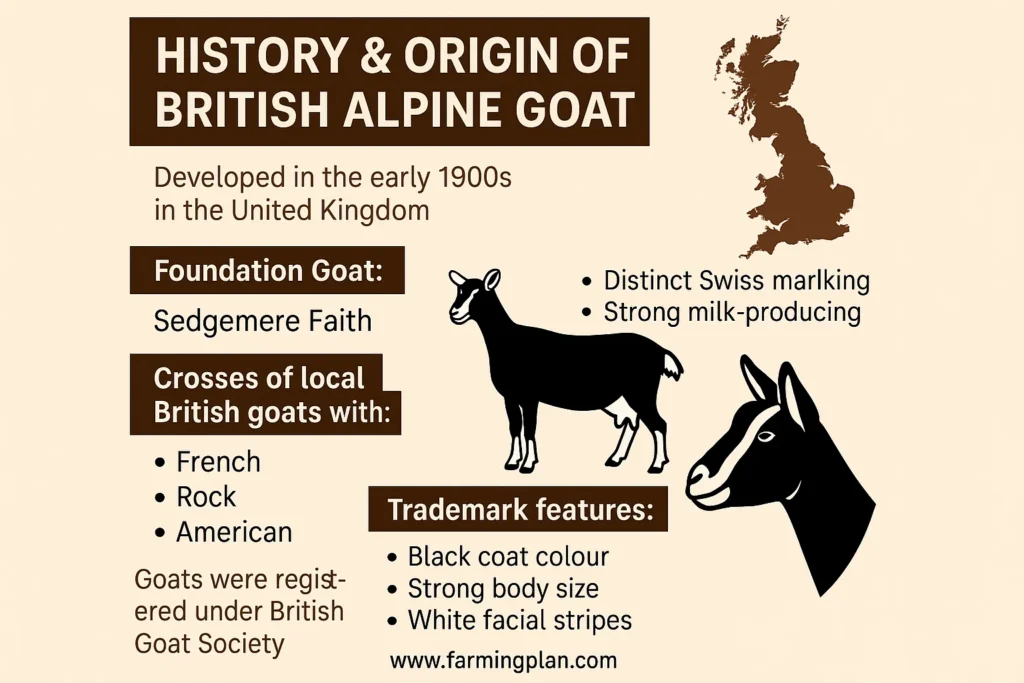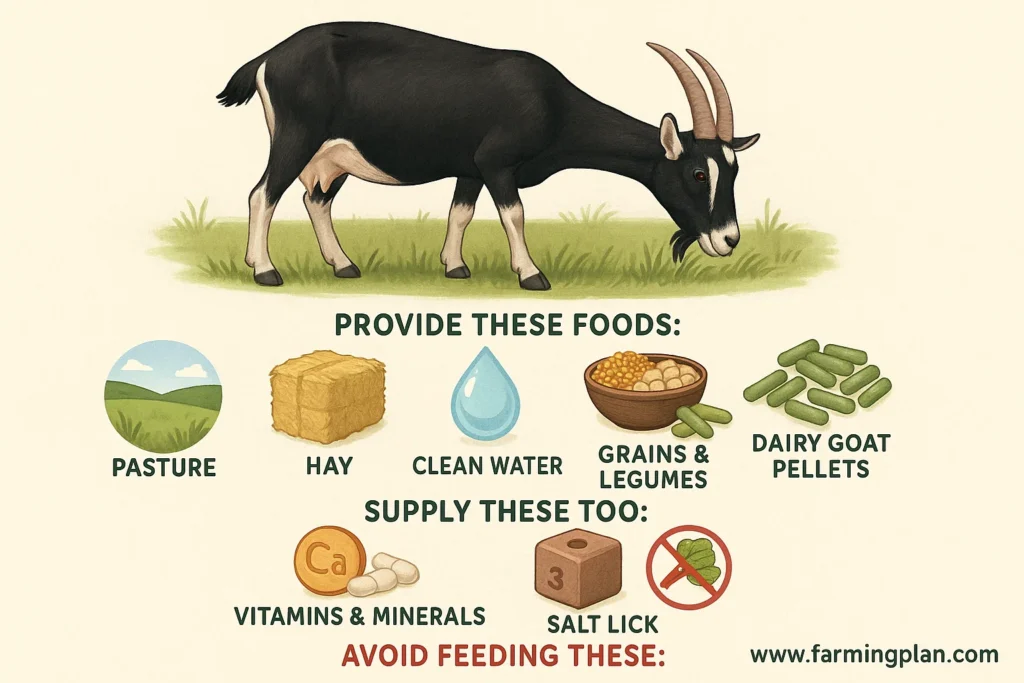The British Alpine Goat is a sleek, black-coated dairy goat known for its striking Swiss white markings, excellent milk production, and easy adaptability to temperate climates. Whether you’re a farmer, breeder, or hobbyist, this elegant goat stands out in both appearance and performance. British Alpines are part of the wider Alpine goat breed, originally developed in the UK by crossing French Alpines, American goats, and local lines to improve both milk quality and hardiness. Thanks to their strong genetics and friendly nature, they’ve become a favorite among goat enthusiasts around the world. If you’re looking for a productive, active, and eye-catching domestic farm animal, the British Alpine Goat is ideal for milk operations, backyard farms, and more.

History & Origin of british alpine goat
The story of the British Alpine Goat is a fascinating one. This breed, developed in the early 1900s in the United Kingdom, is a testament to the ingenuity and dedication of breeders. Their goal was to create a hardy dairy goat that could thrive in British weather, leading them to cross local British goats with French, Rock, and American goats.
One of the key foundation goats was Sedgemere Faith, who carried the distinct Swiss markings and strong milk-producing traits that set the standard for the breed. Over time, careful breeding helped shape the British Alpine’s trademark features, such as its black coat colouring, strong body size, and white facial stripes.

These goats were registered under the British Goat Society, and today, their herd book continues to track lineage and protect the gene pool. Their rise in popularity came from their looks and ability to thrive in temperate climates, perform well in extended lactations, and produce quality milk. British Alpines remain a proud symbol of smart breeding and practical farming in the UK and beyond.
Reads More: Burford Brown Chicken: The Perfect Breed For Happy, Productive Flocks
Characteristics
The British Alpine Goat is known for its bold and elegant look, which is easy to recognize. Its intense black coat, paired with crisp white markings on the face, legs, ears, and under the tail, creates a striking appearance. This pattern, known as Swiss markings, gives the goat a clean and classy look. Some goats may develop a grey undercoat or patches on the barrel and flanks with age, which are common and not considered faults.
These goats are built for both strength and grace. They have an adequate size for ease of handling, a shallow body with a deep chest, and straight legs that support an active lifestyle. Bucks show clear masculinity, with firm testicles, and both Bucks have strong bone structures and alert eyes.
The seats are well-shaped and positioned—ideal for hand or machine milking. Issues like Rudimentary Teats, Double teats, or Supernumerary teats do appear but should be avoided through good breeding. The British Alpine also has short, fine hair around the cheeks and white facial marks that add to its sharp look. These goats exemplify the Alpine goat’s beauty and purpose in a dairy setting.
Nature & Temperament
In my experience, the British Alpine Goat is one of the most energetic and friendly breeds you’ll ever meet. These goats are naturally active, curious, and full of life. They love to move around and explore, which makes them perfect for sunny pastures or larger open spaces. Their energy, stemming from their Alpine roots, helps keep them healthy and alert, and their friendly nature makes them a joy to be around.
Despite their energy, British Alpines are easy to handle. They respond well to gentle training and daily routines. I’ve noticed that they get attached to their caretakers and enjoy human interaction, making them ideal for small family farms and larger operations.
British Alpines are also social animals and prefer the company of other goats. If left alone, they can get restless or bored. It’s important to keep them in small herds to keep their spirits up. Their strong personality and sharp memory make them easy to bond with—and hard to forget. Understanding and catering to their social needs is a key part of caring for these wonderful creatures.
” Always check for rudimentary or double teats in kids before keeping them for breeding. This helps maintain the quality and function of your herd.”
Food & Diet of british alpine goat
Feeding a British Alpine Goat correctly makes all the difference in milk production and overall health. These goats do best on fresh pasture, high-quality hay, and clean water. I always ensure they can access plenty of green forage during the day, especially if they’re grazing in a temperate climate.

I add grains, legumes, and dairy goat pellets for milking to boost their energy and support extended lactations. Their diet should also include vitamins, minerals, and especially calcium for strong teats and bones of goats. Salt licks or loose minerals can help balance out their nutrient intake.
Avoid feeding moldy hay, leftover garden scraps, or anything toxic like avocado or rhubarb to your goat. I always say, “If you wouldn’t eat it, don’t feed it to your goat.” Feeding baby goats? Start them on their mother’s quality milk, then slowly move them to solid food by 8 weeks. Whether you’re running large-scale dairy operations or caring for mini goats at home, diet plays a key role in keeping these animals thriving.
Tip: “To increase daily milk yield, feed your British Alpine in the early morning and just before evening milking. Consistency in feeding keeps their system happy and productive.”
Usage & Purpose
The British Alpine Goat is a true all-rounder, but its main strength lies in being an excellent dairy goat. These goats are heavy milk producers, often giving large quarts of milk per day, even during extended lactation periods. Their high-quality milk has a good fat yield, making it perfect for homemade cheese, butter, or yogurt.
Many farmers, including myself, rely on them for consistent daily milk yield. They perform well in both small homesteads and large feedlot-type operations thanks to their reliable output and easy handling. Their size for ease of milking makes them a top choice in the Alpine Goat Dairy community.
Besides dairy, British Alpines are sometimes used as pack goats because of their strong legs, light frame, and active nature. They’re also popular in shows and goat exhibitions due to their bold coloring and classic Alpine goat breed structure. Whether you’re looking for a common farm animal that pulls its weight or a standout foundation animal for a new herd, the British Alpine Goat is built for both performance and beauty.
Special Features
What sets the British Alpine Goat apart from other breeds are its unique physical and genetic traits. First, there’s the intense black coat with Swiss white markings—a signature look that makes them one of the most eye-catching goats in any herd. Their white hair on the face, legs, and ears, paired with facial stripes and flanks with age, creates a sharp contrast that defines the breed.
Another special trait is their strong tendency for extended lactations. Many of my milk continues to be given long after the usual period, which makes them ideal for year-round dairy operations. Their good-sized teats and double orifices make milking faster and more efficient. British Alpines also carry a recessive gene for color.
This means they can sometimes pass on unique color patterns, adding variety to herds without losing breed standards. Their shallow body and straight legs design gives them excellent mobility and help with pasture-based systems. One of my favorite things about them is their resilience. These goats are known for their hardy characteristics, which make them perfect for British pastures, Australian climates, and anywhere with a mild to cool climate.
Reads More: Powerful Bakharwal Dog: Ancient Guardian With Loyal Heart
Health Issues & Prevention of british alpine goat
Keeping British Alpine Goats healthy is all about routine and observation. They’re generally hardy animals, but like any domestic goat breed, they can face health challenges if not cared for properly. One common issue is parasites, especially when goats graze in wet pastures. I do regular fecal checks and rotate grazing areas to keep parasites under control.

Udder infections like mastitis can also affect milking does, especially if hygiene during milking isn’t top-notch. I always wash hands, clean teats, and sanitize equipment before each session. Goats with rudimentary teats or extra teats may be more prone to infection, so I monitor them closely. Another thing to watch is hoof problems. These goats love walking on pasture, but wet or uneven ground can cause hoof rot. I trim their hooves monthly and check for any bad smells or limping.
Vaccinations and deworming schedules should never be skipped. I stick to a set routine with help from my vet, especially during gestation periods and when raising baby goats. Goats also need shade, clean bedding, and dry shelters to avoid stress-related illness. If you give them proper feed, clean housing, and routine care, British Alpines stay active, productive, and healthy for years.
Step-by-Step Farming Guide for British Alpine Goats
Raising British Alpine Goats takes some planning, but with the right steps, you can enjoy healthy, productive animals.
Step 1: Prepare the Housing
Build a clean, dry shelter with good ventilation. Make sure the space protects your goats from rain, wind, and extreme temperatures. I recommend raised bedding to keep them cozy and dry.
Step 2: Select Quality Stock
Choose goats with strong Alpine goat breed characteristics like a deep body, clear Swiss markings, and good teat placement. Look for healthy bucks and does from reputable breeders to maintain a strong gene pool.
Step 3: Feeding Routine
Provide access to fresh pasture or quality hay daily. Supplement with grains and minerals to support extended lactations and strong bones. Always keep clean water available.
Step 4: Milking Setup
Set up a hygienic milking area—clean teats and equipment before and after milking to prevent infections like mastitis. Consistency in milking times improves daily milk yield.
Step 5: Health Care
Schedule regular vet checkups, vaccinations, and deworming. Keep hooves trimmed and watch for signs of illness like limping or loss of appetite.
Step 6: Breeding and Kidding
Plan breeding for optimal seasons. Monitor does during pregnancy, providing extra nutrition. Prepare a clean birthing area and assist as needed during gestation period and kidding.
Step 7: Record Keeping
Maintain detailed records of breeding, milk production, health treatments, and feeding. This helps track your herd’s progress and identify any issues quickly.
Expert Tips & Best Practices
From my years working with British Alpine Goats, here are some tips that can really boost your success:
- Keep your herd size manageable to maintain adequate size for pasture and handling.
- Select bucks with strong masculinity and good testicles to improve your breeding stock.
- Rotate pastures regularly to reduce parasite loads and improve forage quality.
- Watch for supernumerary teats and avoid breeding goats with this trait to prevent milking complications.
- Maintain a consistent feeding schedule to support their extended lactation periods.
- Use gentle handling to build trust and reduce stress—happy goats produce better milk!
- Protect your goats from extreme weather by providing shade and shelter, especially in temperate climates.
- Monitor milk quality closely if you’re targeting large-scale dairy operations or specialty products like cheese.
- Encourage social interaction by keeping goats in small groups—they thrive with company.
Tip: “Healthy goats come from simple, consistent care routines—stick to your schedule and watch your herd thrive.”
FAQs
What makes British Alpine Goats unique compared to other Alpine breeds?
British Alpines have a distinctive intense black coat with Swiss white markings, plus strong milk production and hardy characteristics suited for temperate climates.
How much milk does a British Alpine Goat produce daily?
On average, they produce a high-quality milk yield of several quarts per day, especially during extended lactation periods.
Are British Alpine Goats good for beginner farmers?
Yes! Their friendly temperament and active nature make them great for beginners, as long as you provide adequate space and consistent care.
What kind of diet do British Alpine Goats need?
They thrive on fresh pasture, quality hay, grains, and mineral supplements, with plenty of clean water available at all times.
Can British Alpine Goats be kept as pets?
Absolutely! They are social and affectionate, making them suitable as pets, but they do best in herds and need room to roam.
Conclusion
The British Alpine Goat stands out as a hardworking, beautiful, and versatile breed. From their striking black coat with Swiss markings to their impressive milk production, they fit perfectly into many farming setups. Their active nature and friendly temperament make them ideal for both new and experienced farmers. Feeding them well with fresh pasture, quality hay, and proper supplements supports their health and extended lactation periods. With proper care—like regular health checks, clean housing, and good breeding practices—British Alpines thrive in temperate climates and beyond. Whether you want a reliable dairy goat or a lively addition to your farm, this breed offers excellent value. They truly combine beauty, strength, and productivity in one remarkable package.
